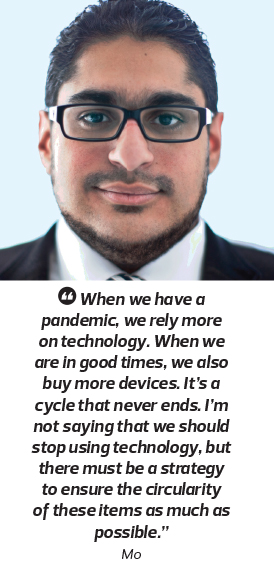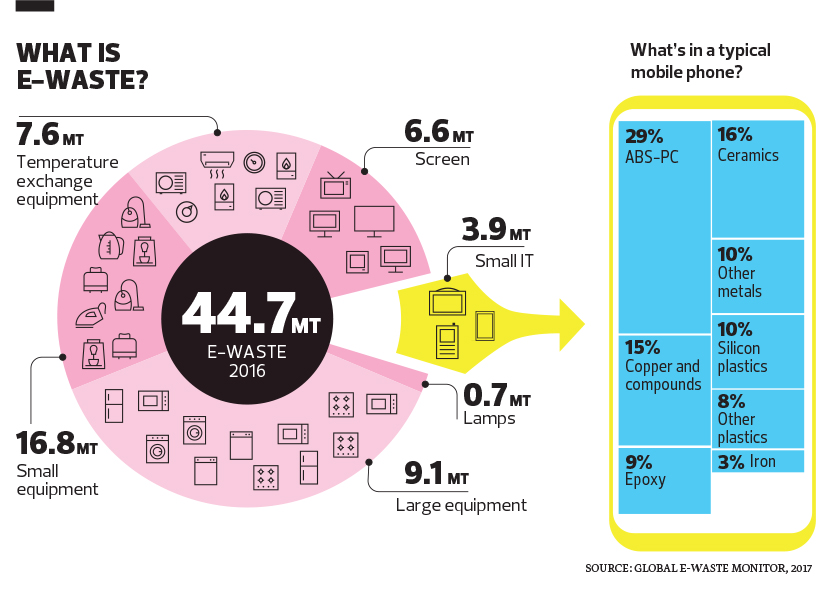
This article first appeared in Digital Edge, The Edge Malaysia Weekly on June 7, 2021 - June 13, 2021
As we venture deeper into the digital economy, it is inevitable that we are also entering the era of e-waste.
Many people may already have smart watches, numerous cheap fitness trackers, e-book readers, headphones, tablets and several old smartphones stashed away in corners of their houses. As the Internet of Things (IoT) and renewable energy take off, there will also be smart fridges, smart lights and solar panels installed in the house.
Eventually, all these things have to be disposed of in some way.
In fact, according to the United Nations’ (UN) Global E-waste Monitor 2020, e-waste is the world’s fastest-growing domestic waste stream. E-waste consists of discarded products with circuitry or electrical components with a power or battery supply. Unfortunately, only 17.4% of e-waste was actually collected and recycled in 2019.
What sets e-waste apart from other wastes is that electronics contain high-value, recoverable materials, such as gold, silver, copper and platinum. The UN report calls e-waste an urban mine, with the value of raw materials in global e-waste in 2019 estimated to be US$57 billion.
It is ironic that all these valuable materials end up in landfills while the rising demand for electronics results in intensified mining of raw materials, which come with their own set of environmental and social impact.
“When we have a pandemic, we rely more on technology. When we are in good times, we also buy more devices. It’s a cycle that never ends. I’m not saying that we should stop using technology, but there must be a strategy to ensure the circularity of these items as much as possible,” says Mohamed “Mo” Tarek El-Fatatry, founder of e-waste collector ERTH.
What’s worse is that product cycles are becoming shorter and people are upgrading their electronics more frequently. Given consumers’ fast-changing preferences, manufacturers build products that aren’t meant to last. This could result in more low-quality waste.
“I remember that we could use TVs up to a decade in the past. Why isn’t that so nowadays? The product manufacturers tell me it’s because consumers only want to use TVs for three to four years. The old products cannot capture advancements in technology, which has made the lifespan of our products, including smartphones, shorter,” says Datuk Jason Yee, co-founder and executive director of licensed e-waste recovery facility Meriahtek (M) Sdn Bhd.
In Malaysia, there is no legal framework that makes it mandatory for consumers to send electrical and electronic items to licensed e-waste recovery facilities. Existing licensed e-waste recovery facilities mostly manage only e-waste from industries, according to the Department of Environment (DoE).
When electrical or electronic items end up in trash cans, they get contaminated. “With that, the electronic item already loses half its value. When the trash collector takes it and mixes it with other trash, the value drops by 90%. By the time it reaches the landfill, nobody wants it any more,” says Mo.
Despite this, the presence of valuable metals in e-waste ensures that scrap collectors will rummage through trash to get to them.
Some people are responsible enough to send their e-waste to licenced e-waste recyclers but these may pay less for the waste because the high cost of following regulated procedures to recover the metals in this waste eats into their margins.
“Their other option is to do open burning. They just burn the component and get the metal. That can give them a higher revenue,” says Mo.
The burning of electronic items and the plastic or rubber casings results in pollution and health hazards. Leaving them in the landfill is not an option either, as e-waste contains toxic additives or hazardous substances such as mercury and lead.
It is hard to tell how much e-waste is actually being collected and recycled in Malaysia because most end up in the informal sector, according to the DoE. But what Huey Chang, management consultant of recycling collection service provider iCYCLE, knows is that the type of e-waste being generated is changing.
Washing machines, refrigerators and air conditioners used to be commonly seen in landfills or dumped at riverbanks. Now, more electronic goods are emerging that could be difficult to recycle, such as tiny IoT devices.
“Most of the time, these devices go to the landfill because nobody bothers to take them apart. The first or second generation of solar panels are also being decommissioned. Currently, people will extract the glass that cannot be recycled because it is coloured and coated. They salvage the aluminium, steel and wires. The rest goes to the landfill,” says Chang.
This points to another grim fact. Even if all e-waste ends up in recycling collection points, not everything can be recycled, reused or refurbished.
“There are two categories of e-waste for recyclers. Phones and laptops have positive value because the recovery or salvage value is higher and can cover our processing cost. Things like fridges don’t have much that is valuable inside other than the compressor, and we have to carefully dispose of the rest of the materials. We also have to take on the final treatment cost,” says Yee.
That is why some recyclers may not want to receive items like washing machines and fridges, given that the processing cost cannot be covered. If the items are not taken by recyclers, they could end up in landfills.
Either that or these items could end up in the informal recycling sector, which does not comply with regulations, says Yee. “They just take apart the frame and compressor. We often see the rest of the fridge dumped at riverbanks,” he notes.
What can be done?
The interviewees are not short on ideas to address these problems. The most pressing need is to ensure that all the electrical and electronic items do not end up in landfills or at illegal recycling operations. What can still be used must be reused or refurbished, while the rest is recycled.
That is why ERTH set up its collection system and pays consumers for sending their e-waste to ERTH; iCYCLE partners with many organisations to take back used electronic goods; Meriahtek, which usually focuses on industrial e-waste, set up collection centres in malls in 2014 to take e-waste off domestic consumers’ hands.
The DoE has proposed new regulations to make it mandatory for consumers to send electrical or electronic goods to licensed recyclers or collectors. However, there has been no update on the proposal.
“The collection infrastructure [for domestic e-waste] is a big challenge. If we want people to properly dispose of their e-waste, we need to work on the infrastructure. Before the regulations are put in place, we are doing trial runs by working with waste contractors and training consumers on how they can work with recycling facilities like ours,” says Yee.
One solution is to establish an extended producer responsibility (EPR) framework, say Yee and Mo. An EPR requires producers or importers to take responsibility for the treatment or disposal of post-consumer products.
“An EPR would levy taxes on importers and manufacturers of electronic items. The taxes will go to a sinking fund that will be used by stakeholders in various parts of the supply chain, for awareness building, collection and recovery,” says Mo. It could also be used to reward consumers who send their e-waste to licensed collectors, for instance.
And, it could also incentivise recyclers to accept items with negative value, such as fridges and washing machines, says Yee.
“Otherwise, everyone is just looking for high value e-waste. If no one takes the other things, they will end up in landfills. After I salvage and recover a washing machine, I can probably sell the materials for RM20 [for example]. But my collection, processing and treatment cost may be RM50. That RM30 should come from the EPR fund. Then, licensed recycling facilities cannot reject these items.”
An EPR system was also part of the DoE’s proposed plans, Yee adds, which will cover six categories of items: TVs, washing machines, fridges, air conditioners, mobile phones and laptops.
At the same time, firming up the regulations for domestic e-waste and enforcement is needed. Chang brings up China, Japan and Canada as examples of countries where segregation of waste at the domestic level is strictly enforced.
The interviewees emphasise that businesses must be proactive and find solutions. For instance, Dell accepts its old equipment for recycling and runs PC-as-a-service programmes for corporations, while Amsterdam-based Fairphone designs smartphones that are meant to last and are easy to be repaired.
Better data collection should also be emphasised in Malaysia, says Chang. “Let’s say we sold 20 million phones in three years and we recycled 10 million. What happened to the other 10 million? With this knowledge, we can devise a strategy to solve the problem.”
Save by subscribing to us for your print and/or digital copy.
P/S: The Edge is also available on Apple's App Store and Android's Google Play.
- Anwar: Malaysia's economic growth may face setback due to US tariff hike
- Selangor Sultan calls off Aidilfitri open house
- Corporate companies step forward to assist Putra Heights fire victims
- Foxconn reports record 1Q revenue, says it must closely watch global politics
- Putra Heights disaster: King visits victims, provides assistance
- Panasonic donates RM120,000 in e-vouchers to support Putra Heights victims
- Opec+ panel stresses compliance after surprise oil output hike
- Putra Heights fire: Airbnb offers 78 temporary homes for victims — Amirudin
- Indonesia's central bank vows to support rupiah amid trade tariffs threat
- Putra Heights fire: 42 victims still warded — MOH




